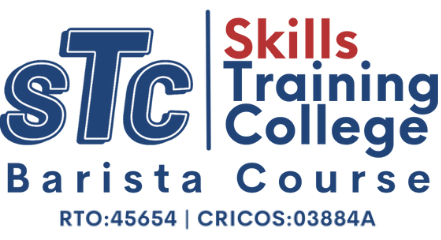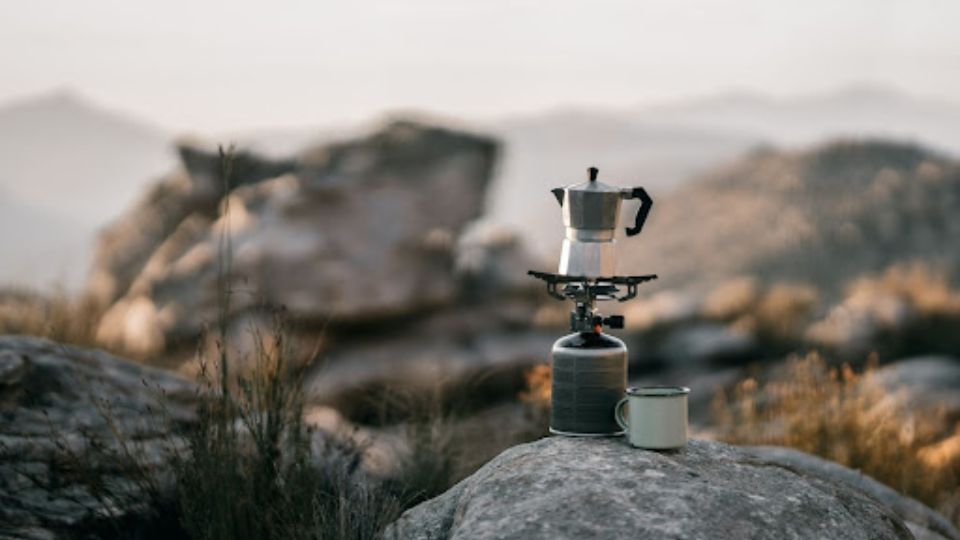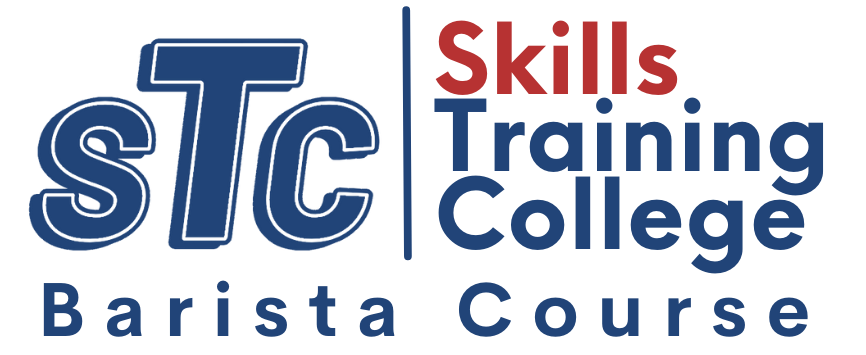Using a brewed coffee compass can be a delicate balance of science and art. If you’re anything like us, you’re constantly testing fresh coffees from various roasters. Yet occasionally, making fresh coffees might be frustrating. One coffee-to-water ratio and grind setting can be perfect for your preferred beans but produce an acidic, bitter cup.
It takes some getting used to when you’re eager to experiment with something new in the world of brewing coffee.
As Coffee connoisseurs and baristas, we’ve discovered some hacks that could save you from a bad morning or a day of coffee acidity.
What is the Problem?
We’re about to debunk the methods causing your coffee to taste sour, and we’ve also devised a coffee compass tool towards the end of this blog that you can use to get it right!
Reading about coffee making certainly enhances your theoretical knowledge, but true learning lies in experimentation and getting trained by barista experts in the coffee industry.
We usually attribute the taste of our coffee to the coffee beans, but is this the case? It could be a result of the brewing process.
The brewing process may have gone wrong if your coffee is bitter, sour, weak, strong, dusty, or watery.
The water in every region tastes different based on its mineral content, which impacts coffee, especially if the water is hard. So we’ve devised our espresso water recipe to help you fix this issue.
What Is The Alternative Brewing Method?
Alternative methods are different methods of brewing coffee that do not require an espresso machine.
These methods give you more control over the extraction, drip and breathing than the machines.
More importantly, they are cost-effective and can be done at home, allowing you to try out different varieties of coffee roasts.
Types of Alternative Brewing Methods Involve:
- Manual Brewing
- The French Press
- Moka Pot
- Pour Over the Filter Cone
- Siphon Coffee Maker
- Pour Over Chemex
- Pour Over Cone
A common method baristas use worldwide is drip brew (under manual brewing), which involves pouring water over ground coffee.
As the water filters through and is drawn downhill by gravity, the coffee is removed, leaving a brew in a carafe or other container beneath the brewer.
Where Does Coffee Get Its Aroma From?
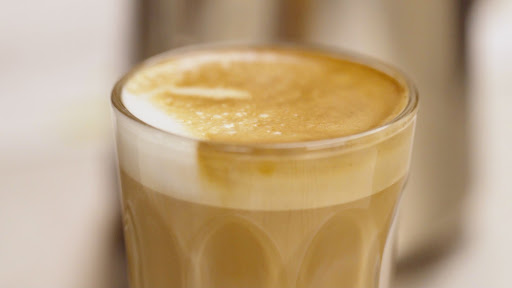
While using the drip technique to brew, some baristas like to include pre-infusion in their protocol. They add a little water to the coffee grounds and wait a particular period of time. This process is effective in soaking coffee grounds in water and expelling extra CO2 that hasn’t been released from the coffee.
The roasted bean contains significant CO2 when coffee is still fresh. The aroma of freshly ground coffee greets us as we approach a café because when coffee is ground, many gases and volatile compounds are emitted.
Although some of the gas is released during grinding, some of it is still trapped in the pore structure of ground coffee.
When this gas comes into contact with water, it tries to escape and causes spontaneous turbulence, which impacts extraction.
Baristas frequently pre-wet coffee grinds to control their extraction process better and prevent uncontrolled brewing of coffee (Sarrazin et al.)
While using the drip technique to brew, some baristas like to include pre-infusion in their protocol. They add a little water to the coffee grounds and wait a particular period of time. This process is effective in soaking coffee grounds in water and expelling extra CO2 that hasn’t been released from the coffee.
The roasted bean contains a significant CO2 when coffee is still fresh. The aroma of freshly ground coffee greets us as we approach a café because when coffee is ground, many gases and volatile compounds are emitted.
Although some of the gas is released during grinding, some of it is still trapped in the pore structure of ground coffee.
When this gas comes into contact with water, it tries to escape and causes spontaneous turbulence, which impacts extraction.
Baristas frequently pre-wet coffee grinds to control their extraction process better and prevent uncontrolled brewing of coffee (Sarrazin et al.).
What Are The Top 5 Coffee Brewing Mistakes?
- The Grind Effect
- Incorrect grind size leads to over/under-extraction. Different coffees require different grinds. Grind size affects extraction via time, flow rate, and contact time. Finer grinds result in higher extraction. Coarser grinds slow extraction, needing longer contact. Espresso needs fine grinds, while cold brew requires coarse.
- The Water
- Soft water yields milder coffee; hard water gives a stronger taste. Minerals in water bond with coffee flavours. Very soft water can make coffee bland, while hard water can overpower it. Filters treat water for better coffee.
- Extraction
- Balanced extraction yields are aromatic, crisp, and mildly bitter flavours. Over-extraction arises from extracting excessively, while under-extraction is too quick, causing puckering. Factors include a coarse grind, inadequate water, incorrect temperature, and insufficient interaction time.
- Coffee Dosage Amounts
- Grind size affects water permeation. Finer grinds extract faster, removing acids, oils, and sediments swiftly. Larger grounds take longer.
- French press uses coarse grinds, brewing in four minutes for a rich cup. Pour-over with medium-fine grinds may take over two minutes for a balanced flavour due to smaller particles.
- Temperature Of Water
- Water temperature significantly affects extraction. Higher temperatures extract oils, acids, and caffeine quickly, making control harder. Excessive heat can lead to over-extraction and harsh coffee. Lower temperatures may cause under-extraction, resulting in sourness and a lack of body. Balanced flavour requires proper temperature for extracting sweetness and bitterness while retaining the body.
How To Correct These 5 Coffee Brewing Mistakes
- Grind Size
- The quality and flavour of each cup of coffee are influenced by the extraction process, which is influenced by the grind size. Take, for example, a coarse grind similar to what you would use in a French press or for a cold brew. Because ground coffee has a relatively low surface area (compared to finer grinds) and requires more time to extract, we submerge or immerse it in water (Fisher et al.).
Grind sizes can range from highly coarse to superfine, with varied consistencies:
The French Press — For best results, the grind size should be coarse with a particle size of 1 mm and a consistency similar to rock salt.
Chemex, Pour Over, Drip Coffee — The ideal grind size should be maintained at a medium range, similar to beach sand, with 0.75 particle size and consistency of beach sand.
Siphon Brewer, Moka Pot, Pour Over Cone — The best grind size is medium fine with a particle size of 0.5 mm and the consistency of table salt.
Your coffee may need to be more coarsely ground if it tastes acidic and runny. See if a finer grind resolves the problem. Your coffee may be too finely ground if it tastes excessively harsh. Your brew may benefit from a coarser grind. (Brew time and temperature will also have an impact on flavour.)
- Water Quality
- To enhance the coffee flavour at home, use a clear filter jug to reduce calcium buildup. Accumulated calcium can affect your coffee maker’s efficiency, causing issues like reduced steam pressure, slower water flow, or leaks. Address these problems promptly. Home machines can benefit from acid-based solutions, while commercial ones may require more extensive measures due to significant calcium buildup.
- Extraction
- To fix over-extraction, adjust either grind size or brewing time. Opt for a coarser grind or reduce brew time by 30 seconds. Simplify by shortening brew time with an immersion brewer. If needed, coarsen the grind.
- For pour-over, speed up draining by slightly coarsening the grind (which shortens overall brew time) or adding more water.
- Coffee Dosage
- Higher doses of coffee grains will lead to longer extraction time and impact the process differently. Similarly, lower amounts of coffee might not do justice to the cup, leaving it under-extracted.
French Press — Maintain the coffee-to-water ratio of 1:12
Moka Pot — The ideal brewing ratio of 1:10
Chemex — The grind size ratio is 1:17
Cold Brew — The grind size should be at a brewing ratio of 9:40
- Adjusting Water Temperature
- The National Coffee Association states that 195°F to 205°F, or a touch below water’s boiling point of 212°F, is the appropriate water temperature for extraction. This range suits various brewing methods like French press or pour-over. Adjust temperature based on roast: higher for lighter, lower for darker to avoid harsh flavours and over-extraction.
How To Correct These Mistakes Using A Brewed Coffee Compass
What Is A Coffee Compass?
A coffee compass is a tool that may be used to map out the many flavours found in a cup of coffee. It is simple to use and can assist you in determining how well the various flavours in your bean-to-brew ratio are balanced.
This coffee compass lets you test out the best way to get your coffee brew right. It can help you balance your taste and get those combinations in place. If you’re wondering where to find one, check out the one we’ve created below.
How To Use This Coffee Compass
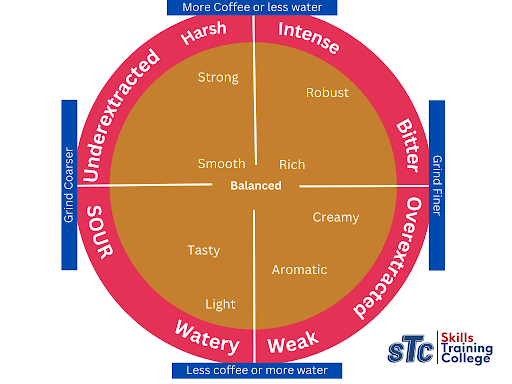
We’ve put this compass together for you. Now it’s your turn to determine where your coffee sits on this spectrum.
Quick Finish — When coffee is properly extracted, the flavour lingers for several minutes instead of a quick finish, where the flavour immediately fades away.
Harsh — Uncomfortably tough on the tongue and severely out of balance.
Sour — Think of vinegar or sour pickles when you get a dry, prickly feeling in your mouth.
Overwhelming — When the coffee is no longer palatable because it is too robust or powerful.
Conclusion
Once you figure out where your bad coffee fits on the compass, adjust it to get to the centre. If your coffee tastes salty or sour, it indicates under extraction, which means you go back to check your water temperature, ratios, quality and other factors to fix it.
A coffee compass is a helpful tool when you brew coffee because it serves as a guide to navigating your coffee-to-water ratios, consistency, taste and richness to produce your best cup of coffee at home.
We recommend printing out this coffee compass to place it near your coffee maker, but it can’t replace the hands-on experience from a Barista Training Institute for gaining true expertise in coffee making.
Reference
- Chin, Tyler. “How to Properly Grind Coffee Beans, according to Experts.” Gear Patrol, 8 Oct. 2022.
- Coffee Roasters, Giesen. “The Drip Method | Knowledge Base.” Giesen Coffee Roasters, Accessed 12 Apr. 2023.
- Fisher, Karl, et al. “French Press 101: 26 Tips from Professional Baristas.” Accessed 12 Apr. 2023.
- Ryan, Sheryl. “Easy Hacks to Remove Mineral Deposits from Coffee Makers, Faucets and More.” Greenopedia, 1 Oct. 2015. Accessed 12 Apr. 2023.
- Sarrazin, Céline, et al. “Representativeness of Coffee Aroma Extracts.” Food Chemistry, vol. 70, no. 1, July 2000, pp. 99–106, Accessed 6 Apr. 2020.
